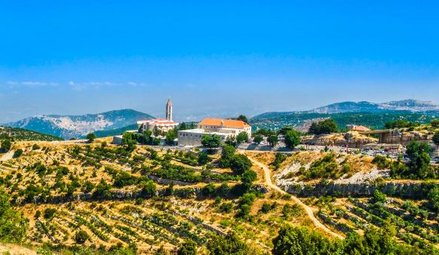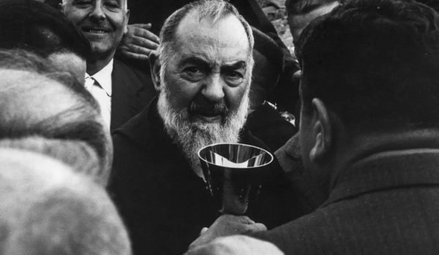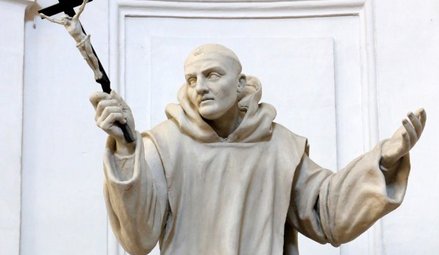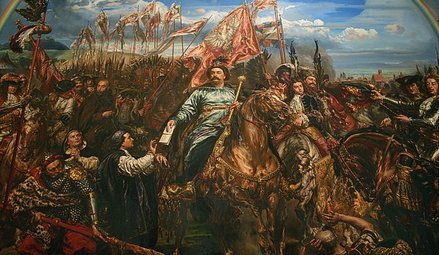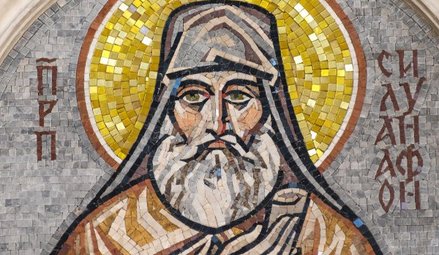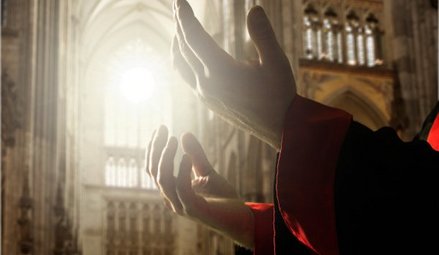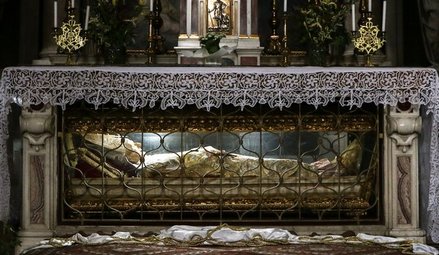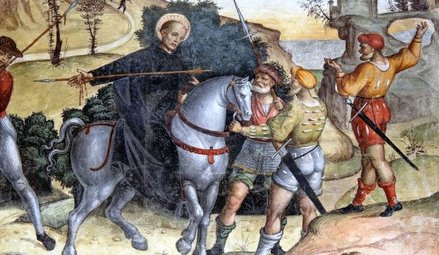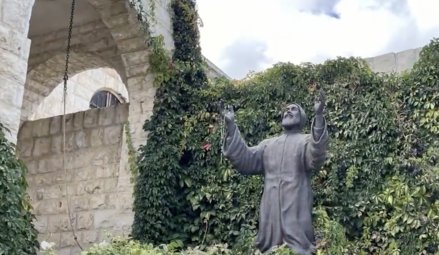- By theme
- Jesus
- The many proofs of Christ’s resurrection
- Saint Thomas Aquinas: God gave all the divine proofs we needed to believe
- The surpassing power of Christ's word
- Lewis’s trilemma: a proof of Jesus’s divinity
- God saves: the power of the holy name of Jesus
- Jesus spoke and acted as God's equal
- Jesus' divinity is actually implied in the Koran
- Jesus came at the perfect time of history
- Rabbinical sources testify to Jesus' miracles
- Mary
- The Church
- The Bible
- An enduring prophecy and a series of miraculous events preventing the reconstruction of the Temple
- The authors of the Gospels were either eyewitnesses or close contacts of those eyewitnesses
- Onomastics support the historical reliability of the Gospels
- The New Testament was not altered
- The New Testament is the best-attested manuscript of Antiquity
- The Gospels were written too early after the facts to be legends
- Archaeological finds confirm the reliability of the New Testament
- The criterion of embarrassment proves that the Gospels tell the truth
- The dissimilarity criterion strengthens the case for the historical reliability of the Gospels
- 84 details in Acts verified by historical and archaeological sources
- The unique prophecies that announced the Messiah
- The time of the coming of the Messiah was accurately prophesied
- The prophet Isaiah's ultra accurate description of the Messiah's sufferings
- Daniel's "Son of Man" is a portrait of Christ
- The Apostles
- Saint Peter, prince of the apostles
- Saint John the Apostle: an Evangelist and Theologian who deserves to be better known (d. 100)
- Saint Matthew, apostle, evangelist and martyr (d. 61)
- James the Just, “brother” of the Lord, apostle and martyr (d. 62 AD)
- Saint Matthias replaces Judas as an apostle (d. 63)
- The martyrs
- The protomartyr Saint Stephen (d. 31)
- Polycarp, bishop of Smyrna, disciple of John and martyr (d. 155)
- Justin Martyr: philosopher and apologist (d.165)
- Saint Blandina and the Martyrs of Lyon: the fortitude of faith (177 AD)
- Saint Agatha stops a volcano from destroying the city of Catania (d. 251)
- Saint Lucy of Syracuse, virgin and martyr for Christ (d. 304)
- Saint Boniface propagates Christianity in Germany (d. 754)
- Thomas More: “The king’s good servant, but God’s first”
- The martyrdom of Paul Miki and his companions (d. 1597)
- The martyrs of Angers and Avrillé (1794)
- The Martyrs of Compiègne (1794)
- The Vietnamese martyrs Father Andrew Dung-Lac and his 116 companions (17th-19th centuries)
- He braved torture to atone for his apostasy (d. 1818)
- Blaise Marmoiton: the epic journey of a missionary to New Caledonia (d. 1847)
- The Uganda martyrs: a recurring pattern in the persecution of Christians (1885)
- José Luis Sanchez del Rio, martyred at age 14 for Christ the King (d. 1928)
- Saint Maximilian Kolbe, Knight of the Immaculate (d. 1941)
- The monks
- The Desert Fathers (3rd century)
- Saint Anthony of the Desert, a father of monasticism (d. 356)
- Saint Benedict, father of Western monasticism (d. 550)
- Saint Bruno the Carthusian (d.1101): the miracle of a hidden life
- Blessed Angelo Agostini Mazzinghi: the Carmelite with flowers pouring from his mouth (d. 1438)
- Monk Abel of Valaam's accurate prophecies about Russia (d. 1841)
- The more than 33,000 miracles of Saint Charbel Maklouf (d. 1898)
- Saint Pio of Pietrelcina (d. 1968): How God worked wonders through "a poor brother who prays"
- The surprising death of Father Emmanuel de Floris (d. 1992)
- The prophecies of Saint Paisios of Mount Athos (d. 1994)
- The saints
- Saints Anne and Joachim, parents of the Virgin Mary (19 BC)
- Saint Nazarius, apostle and martyr (d. 68 or 70)
- Ignatius of Antioch: successor of the apostles and witness to the Gospel (d. 117)
- Saint Gregory the Miracle-Worker (d. 270)
- Saint Martin of Tours: patron saint of France, father of monasticism in Gaul, and the first great leader of Western monasticism (d. 397)
- Saint Augustine of Canterbury evangelises England (d. 604)
- Saint Lupus, the bishop who saved his city from the Huns (d. 623)
- Saint Rainerius of Pisa: from musician to merchant to saint (d. 1160)
- Saint Dominic of Guzman (d.1221): an athlete of the faith
- Saint Francis, the poor man of Assisi (d. 1226)
- Saint Anthony of Padua: "everyone’s saint"
- Saint Rose of Viterbo or How prayer can transform the world (d. 1252)
- Saint Simon Stock receives the scapular of Mount Carmel from the hands of the Virgin Mary
- The unusual boat of Saint Basil of Ryazan
- Saint Agnes of Montepulciano's complete God-confidence (d. 1317)
- The extraordinary conversion of Michelina of Pesaro
- Saint Peter Thomas (d. 1366): a steadfast trust in the Virgin Mary
- Saint Rita of Cascia: hoping against all hope
- Saint Catherine of Genoa and the Fire of God's love (d. 1510)
- Saint Anthony Mary Zaccaria, physician of bodies and souls (d. 1539)
- Saint Ignatius of Loyola (d. 1556): "For the greater glory of God"
- Brother Alphonsus Rodríguez, SJ: the "holy porter" (d. 1617)
- Martin de Porres returns to speed up his beatification (d. 1639)
- Virginia Centurione Bracelli: When God is the only goal, all difficulties are overcome (d.1651)
- Saint Marie of the Incarnation, "the Teresa of New France" (d.1672)
- St. Francis di Girolamo's gift of reading hearts and souls (d. 1716)
- Rosa Venerini: moving in the ocean of the Will of God (d. 1728)
- Saint Jeanne-Antide Thouret: heroic perseverance and courage (d. 1826)
- Seraphim of Sarov (1759-1833): the purpose of the Christian life is to acquire the Holy Spirit
- Camille de Soyécourt, filled with divine fortitude (d. 1849)
- Bernadette Soubirous, the shepherdess who saw the Virgin Mary (1858)
- Saint John Vianney (d. 1859): the global fame of a humble village priest
- Gabriel of Our Lady of Sorrows, the "Gardener of the Blessed Virgin" (d. 1862)
- Father Gerin, the holy priest of Grenoble (1863)
- Blessed Francisco Palau y Quer: a lover of the Church (d. 1872)
- Saints Louis and Zelie Martin, the parents of Saint Therese of Lisieux (d. 1894 and 1877)
- The supernatural maturity of Francisco Marto, “contemplative consoler of God” (d. 1919)
- Saint Faustina, apostle of the Divine Mercy (d. 1938)
- Brother Marcel Van (d.19659): a "star has risen in the East"
- Doctors
- The mystics
- Lutgardis of Tongeren and the devotion to the Sacred Heart
- Saint Angela of Foligno (d. 1309) and "Lady Poverty"
- Saint John of the Cross: mystic, reformer, poet, and universal psychologist (+1591)
- Blessed Anne of Jesus: a Carmelite nun with mystical gifts (d.1621)
- Catherine Daniélou: a mystical bride of Christ in Brittany
- Saint Margaret Mary sees the "Heart that so loved mankind"
- Jesus makes Maria Droste zu Vischering the messenger of his Divine Heart (d. 1899)
- Mother Yvonne-Aimée of Jesus' predictions concerning the Second World War (1922)
- Sister Josefa Menendez, apostle of divine mercy (d. 1923)
- Edith Royer (d. 1924) and the Sacred Heart Basilica of Montmartre
- Rozalia Celak, a mystic with a very special mission (d. 1944)
- Visionaries
- Saint Perpetua delivers her brother from Purgatory (203)
- María de Jesús de Ágreda, abbess and friend of the King of Spain
- Discovery of the Virgin Mary's house in Ephesus (1891)
- Sister Benigna Consolata: the "Little Secretary of Merciful Love" (d. 1916)
- Maria Valtorta's visions match data from the Israel Meteorological Service (1943)
- Berthe Petit's prophecies about the two world wars (d. 1943)
- Maria Valtorta saw only one pyramid at Giza in her visions... and she was right! (1944)
- The location of Saint Peter's village seen in a vision before its archaeological discovery (1945)
- The 700 extraordinary visions of the Gospel received by Maria Valtorta (d. 1961)
- The amazing geological accuracy of Maria Valtorta's writings (d. 1961)
- Maria Valtorta's astronomic observations consistent with her dating system
- Discovery of an ancient princely house in Jerusalem, previously revealed to a mystic (d. 1961)
- Mariette Kerbage, the seer of Aleppo (1982)
- The 20,000 icons of Mariette Kerbage (2002)
- The popes
- The great witnesses of the faith
- Saint Augustine's conversion: "Why not this very hour make an end to my uncleanness?" (386)
- Thomas Cajetan (d. 1534): a life in service of the truth
- Madame Acarie, "the servant of the servants of God" (d. 1618)
- Blaise Pascal (d.1662): Biblical prophecies are evidence
- Madame Élisabeth and the sweet smell of virtue (d. 1794)
- Jacinta, 10, offers her suffering to save souls from hell (d. 1920)
- Father Jean-Édouard Lamy: "another Curé of Ars" (d. 1931)
- Christian civilisation
- The depth of Christian spirituality
- John of the Cross' Path to perfect union with God based on his own experience
- The dogma of the Trinity: an increasingly better understood truth
- The incoherent arguments against Christianity
- The "New Pentecost": modern day, spectacular outpouring of the Holy Spirit
- The Christian faith explains the diversity of religions
- Cardinal Pierre de Bérulle (d.1629) on the mystery of the Incarnation
- Christ's interventions in history
- Marian apparitions and interventions
- The Life-giving Font of Constantinople
- Apparition of Our Lady of La Treille in northern France: prophecy and healings (600)
- Our Lady of Virtues saves the city of Rennes in Bretagne (1357)
- Mary stops the plague epidemic at Mount Berico (1426)
- Our Lady of Miracles heals a paralytic in Saronno (1460)
- Cotignac: the first apparitions of the Modern Era (1519)
- Savona: supernatural origin of the devotion to Our Lady of Mercy (1536)
- The Virgin Mary delivers besieged Christians in Cusco, Peru
- The victory of Lepanto and the feast of Our Lady of the Rosary (1571)
- The apparitions to Brother Fiacre (1637)
- The “aldermen's vow”, or the Marian devotion of the people of Lyon (1643)
- Our Lady of Nazareth in Plancoët, Brittany (1644)
- Our Lady of Laghet (1652)
- Saint Joseph’s apparitions in Cotignac, France (1660)
- Heaven confides in a shepherdess of Le Laus (1664-1718)
- Zeitoun, a two-year miracle (1968-1970)
- The Holy Name of Mary and the major victory of Vienna (1683)
- Heaven and earth meet in Colombia: the Las Lajas shrine (1754)
- The five Marian apparitions that traced an "M" over France, and its new pilgrimage route
- A series of Marian apparitions and prophetic messages in Ukraine since the 19th century (1806)
- "Consecrate your parish to the Immaculate Heart of Mary" (1836)
- At La Salette, Mary wept in front of the shepherds (1846)
- Our Lady of Champion, Wisconsin: the first and only approved apparition of Mary in the US (1859)
- Gietrzwald apparitions: heavenly help to a persecuted minority
- The silent apparition of Knock Mhuire in Ireland (1879)
- Mary "Abandoned Mother" appears in a working-class district of Lyon, France (1882)
- The thirty-three apparitions of the Virgin Mary in Beauraing (1932)
- "Our Lady of the Poor" appears eight times in Banneux (1933)
- Fontanelle-Montichiari apparitions of Our Lady "Rosa Mystica" (1947)
- Mary responds to the Vows of the Polish Nation (1956)
- Zeitoun apparitions
- The Virgin Mary comes to France's rescue by appearing at L'Ile Bouchard (1947)
- Maria Esperanza Bianchini and Mary, Mary, Reconciler of Peoples and Nations (1976)
- Luz Amparo and the El Escorial apparitions
- The extraordinary apparitions of Medjugorje and their worldwide impact
- The Virgin Mary prophesied the 1994 Rwandan genocide (1981)
- Our Lady of Soufanieh's apparition and messages to Myrna Nazzour (1982)
- The Virgin Mary heals a teenager, then appears to him dozens of times (1986)
- Seuca, Romania: apparitions and pleas of the Virgin Mary, "Queen of Light" (1995)
- Angels and their manifestations
- Mont Saint-Michel: Heaven watching over France
- The revelation of the hymn Axion Estin by the Archangel Gabriel (982)
- Angels give a supernatural belt to the chaste Thomas Aquinas (1243)
- The constant presence of demons and angels in the life of St Frances of Rome (d. 1440)
- Mother Yvonne-Aimée escapes from prison with the help of an angel (1943)
- Saved by Angels: The Miracle on Highway 6 (2008)
- Exorcisms in the name of Christ
- A wave of charity unique in the world
- Saint Peter Nolasco: a life dedicated to ransoming enslaved Christians (d. 1245)
- Rita of Cascia forgives her husband's murderer (1404)
- Saint Angela Merici: Christ came to serve, not to be served (d. 1540)
- Saint John of God: a life dedicated to the care of the poor, sick and those with mental disorders (d. 1550)
- Saint Camillus de Lellis, reformer of hospital care (c. 1560)
- Blessed Alix Le Clerc, encouraged by the Virgin Mary to found schools (d. 1622)
- Saint Vincent de Paul (d. 1660), apostle of charity
- Marguerite Bourgeoys, Montreal's first teacher (d. 1700)
- Frédéric Ozanam, inventor of the Church's social doctrine (d. 1853)
- Damian of Molokai: a leper for Christ (d. 1889)
- Pier Giorgio Frassati (d.1925): heroic charity
- Saint Dulce of the Poor, the Good Angel of Bahia (d. 1992)
- Mother Teresa of Calcutta (d. 1997): an unshakeable faith
- Heidi Baker: Bringing God's love to the poor and forgotten of the world
- Amazing miracles
- The miracle of liquefaction of the blood of St. Januarius (d. 431)
- The miracles of Saint Anthony of Padua (d. 1231)
- Saint Pius V and the miracle of the Crucifix (1565)
- Saint Philip Neri calls a teenager back to life (1583)
- The resurrection of Jérôme Genin (1623)
- Saint Francis de Sales brings back to life a victim of drowning (1623)
- Saint John Bosco and the promise kept beyond the grave (1839)
- The day the sun danced at Fatima (1917)
- Pius XII and the miracle of the sun at the Vatican (1950)
- When Blessed Charles de Foucauld saved a young carpenter named Charle (2016)
- Reinhard Bonnke: 89 million conversions (d. 2019)
- Miraculous cures
- The royal touch: the divine thaumaturgic gift granted to French and English monarchs (11th-19th centuries)
- With 7,500 cases of unexplained cures, Lourdes is unique in the world (1858-today)
- Our Lady at Pellevoisin: "I am all merciful" (1876)
- Mariam, the "little thing of Jesus": a saint from East to West (d.1878)
- The miraculous healing of Marie Bailly and the conversion of Dr. Alexis Carrel (1902)
- Gemma Galgani: healed to atone for sinners' faults (d. 1903)
- The miraculous cure of Blessed Maria Giuseppina Catanea
- The extraordinary healing of Alice Benlian in the Church of the Holy Cross in Damascus (1983)
- The approved miracle for the canonization of Juan Diego Cuauhtlatoatzin (1990)
- Healed by St Charbel Makhlouf, her scars bleed each month for the benefit of unbelievers (1993)
- The miracle that led to Brother André's canonisation (1999)
- Bruce Van Natta's intestinal regrowth: an irrefutable miracle (2007)
- He had “zero” chance of living: a baby's miraculous recovery (2015)
- Manouchak, operated on by Saint Charbel (2016)
- How Maya was cured from cancer at Saint Charbel's tomb (2018)
- Preserved bodies of the saints
- Dying in the odour of sanctity
- The body of Saint Cecilia found incorrupt (d. 230)
- Saint Claudius of Besançon: a quiet leader, a calm presence, and a strong belief in the value of prayer (d. 699)
- Stanislaus Kostka's burning love for God (d. 1568)
- Saint Germaine of Pibrac: God's little Cinderella (d. 1601)
- Blessed Antonio Franco, bishop and defender of the poor (d. 1626)
- Giuseppina Faro, servant of God and of the poor (d. 1871)
- The incorrupt body of Marie-Louise Nerbollier, the visionary from Diémoz (d. 1910)
- The great exhumation of Saint Charbel (1950)
- Bilocations
- Inedias
- Levitations
- Lacrimations and miraculous images
- Saint Juan Diego's tilma (1531)
- The Rue du Bac apparitions of the Virgin Mary to St. Catherine Labouré (Paris, 1830)
- Mary weeps in Syracuse (1953)
- Teresa Musco (d.1976): salvation through the Cross
- Soufanieh: A flow of oil from an image of the Virgin Mary, and oozing of oil from the face and hands of Myrna Nazzour (1982)
- The Saidnaya icon exudes a wonderful fragrance (1988)
- Our Lady weeps in a bishop's hands (1995)
- Stigmates
- The venerable Lukarda of Oberweimar shares her spiritual riches with her convent (d. 1309)
- Florida Cevoli: a heart engraved with the cross (d. 1767)
- Blessed Maria Grazia Tarallo, mystic and stigmatist (d. 1912)
- Saint Padre Pio: crucified by Love (1918)
- Elena Aiello: "a Eucharistic soul"
- A Holy Triduum with a Syrian mystic, witnessing the sufferings of Christ (1987)
- A Holy Thursday in Soufanieh (2004)
- Eucharistic miracles
- Lanciano: the first and possibly the greatest Eucharistic miracle (750)
- A host came to her: 11-year-old Imelda received Communion and died in ecstasy (1333)
- Faverney's hosts miraculously saved from fire
- A tsunami recedes before the Blessed Sacrament (1906)
- Buenos Aires miraculous host sent to forensic lab, found to be heart muscle (1996)
- Relics
- The Veil of Veronica, known as the Manoppello Image
- For centuries, the Shroud of Turin was the only negative image in the world
- The Holy Tunic of Argenteuil's fascinating history
- Saint Louis (d. 1270) and the relics of the Passion
- The miraculous rescue of the Shroud of Turin (1997)
- A comparative study of the blood present in Christ's relics
- Jews discover the Messiah
- Francis Xavier Samson Libermann, Jewish convert to Catholicism (1824)
- Our Lady of the Miraculous Medal and the conversion of Alphonse Ratisbonne (1842)
- Max Jacob: a liberal gay Jewish artist converts to Catholicism (1909)
- Edith Stein - Saint Benedicta of the Cross: "A daughter of Israel who, during the Nazi persecutions, remained united with faith and love to the Crucified Lord, Jesus Christ, as a Catholic, and to her people as a Jew"
- Patrick Elcabache: a Jew discovers the Messiah after his mother is miraculously cured in the name of Jesus
- Olivier's conversion story: from Pesach to the Christian Easter (2000)
- Cardinal Aron Jean-Marie Lustiger (d. 2007): Chosen by God
- Muslim conversions
- He met Jesus while looking for Muhammad (1990)
- Selma's journey to baptism (1996)
- Soumia, converted to Jesus as she hears Christmas carols (2003)
- How Aïsha, a Muslim convert, found Jesus (2004)
- Amir chooses Christ, at the risk of becoming homeless (2004)
- Souad Brahimi: brought to Jesus by Mary (2012)
- Pursued by God: Khadija's story (2023)
- Buddhist conversions
- Atheist conversions
- The conversion of an executioner during the Terror (1830)
- God woos a poet's heart: the story of Paul Claudel's conversion (1886)
- From agnostic to Catholic Trappist monk (1909)
- Dazzled by God: Madeleine Delbrêl's story (1924)
- C.S. Lewis, the reluctant convert (1931)
- The day André Frossard met Christ in Paris (1935)
- MC Solaar's rapper converts after experiencing Jesus' pains on the cross
- Father Sébastien Brière, converted at Medjugorje (2003)
- Franca Sozzani, the "Pope of fashion" who wanted to meet the Pope (2016)
- Nelly Gillant: from Reiki Master to Disciple of Christ (2018)
- Testimonies of encounters with Christ
- Near-death experiences (NDEs) confirm Catholic doctrine on the Four Last Things
- The NDE of Saint Christina the Astonishing, a source of conversion to Christ (1170)
- Jesus audibly calls Alphonsus Liguori to follow him (1723)
- Blessed Dina Bélanger (d. 1929): loving God and letting Jesus and Mary do their job
- Gabrielle Bossis: He and I
- André Levet's conversion in prison
- Journey between heaven and hell: a "near-death experience" (1971)
- Jesus' message to Myrna Nazzour (1984)
- Alicja Lenczewska: conversations with Jesus (1985)
- Vassula Ryden and the "True Life in God" (1985)
- Nahed Mahmoud Metwalli: from persecutor to persecuted (1987)
- The Bible verse that converted a young Algerian named Elie (2000)
- Invited to the celestial court: the story of Chantal (2017)
- Providential stories
- The superhuman intuition of Saint Pachomius the Great
- Ambrose of Milan finds the bodies of the martyrs Gervasius and Protasius (386)
- Germanus of Auxerre's prophecy about Saint Genevieve's future mission, and protection of the young woman (446)
- Seven golden stars reveal the future location of the Grande Chartreuse Monastery (1132)
- The supernatural reconciliation of the Duke of Aquitaine (1134)
- Saint Zita and the miracle of the cloak (13th c.)
- Joan of Arc: "the most beautiful story in the world"
- John of Capistrano saves the Church and Europe (1456)
- A celestial music comforts Elisabetta Picenardi on her deathbed (d. 1468)
- Gury of Kazan: freed from his prison by a "great light" (1520)
- The strange adventure of Yves Nicolazic (1623)
- Julien Maunoir miraculously learns Breton (1626)
- Pierre de Keriolet: with Mary, one cannot be lost (1636)
- How Korea evangelized itself (18th century)
- A hundred years before it happened, Saint Andrew Bobola predicted that Poland would be back on the map (1819)
- The prophetic poem about John Paul II (1840)
- Don Bosco's angel dog: Grigio (1854)
- The purifying flames of Sophie-Thérèse de Soubiran La Louvière (1861)
- Thérèse of Lisieux saved countless soldiers during the Great War
- Lost for over a century, a Russian icon reappears (1930)
- In 1947, a rosary crusade liberated Austria from the Soviets (1946-1955)
- The discovery of the tomb of Saint Peter in Rome (1949)
- He should have died of hypothermia in Soviet jails (1972)
- God protects a secret agent (1975)
- Flowing lava stops at church doors (1977)
- A protective hand saved John Paul II and led to happy consequences (1981)
- Mary Undoer of Knots: Pope Francis' gift to the world (1986)
- Edmond Fricoteaux's providential discovery of the statue of Our Lady of France (1988)
- The Virgin Mary frees a Vietnamese bishop from prison (1988)
- The miracles of Saint Juliana of Nicomedia (1994)
- Global launch of "Pilgrim Virgins" was made possible by God's Providence (1996)
- The providential finding of the Mary of Nazareth International Center's future site (2000)
- Syrian Monastery shielded from danger multiple times (2011-2020)
- Jesus
- Who are we?
- Make a donation
TOUTES LES RAISONS DE CROIRE
Les moines
n°73
Saint Maron Monastery in Annaya, Lebanon
1828-1898
The more than 33,000 miracles of Saint Charbel Maklouf
Charbel Maklouf was born into a poor shepherd family in Lebanon. From an early age, he was attracted to the monastic life. At the age of 20, he entered the Maronite monastery of Our Lady of Mayfouq, and was ordained a priest in 1859. He then spent sixteen years in the Saint Maron monastery in Annaya, before retiring to a nearby hermitage. Charbel died on December 24, 1898, on Christmas Eve. This humble 19th-century Maronite monk has become a national symbol in Lebanon. He is one of the saints to whom the Church attributes the most miracles - more than 33,000 as of July 2024, according to the records of Saint Maron Monastery - some of which are unique in the history of Christianity.
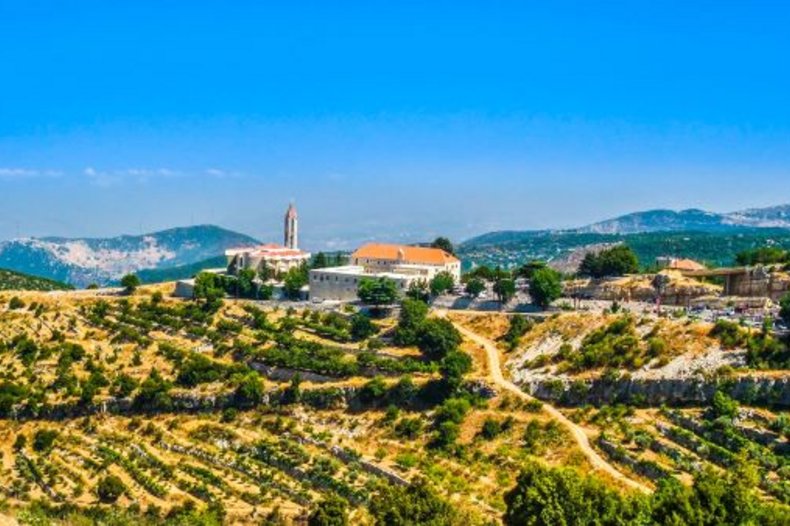
Monastery of Saint Maron, sanctuary of Saint Charbel, Annaya, Lebanon / © CC BY-SA 4.0/Paul Saad
Les raisons d'y croire :
- The facts speak for themselves. One cannot invent the hundreds of thousands of reported miracles that occurred not only during Saint Charbel's life, but still continue happening to this day. Their incredible number and the detailed, documented types of cures obtained through the saint's prayers prove that they are authentic, just as the impressive number of healed persons and witnesses, numbering in the thousands, rule out the hypothesis of illusions or hallucinations.
- Some of those miracles were seen and attested by whole crowds of witnesses, such as the mysterious light that appeared for a long time after the saint's death at the site of his tomb.
- The theory of "emotional contagion" or "mental suggestion" does not hold up in the face of the many physical cures on record. What's more, 10% of the beneficiaries of Saint Charbel's miracles are non-Christian from all religions as well as agnostic persons.
- The saint's actions on behalf on people who pray for his intercession are similar to those of Jesus in the Gospels, and to those of countless saints throughout the centuries. And like Jesus' miracles, Saint Charbel's miracles touch not only the body, but also the soul of those who receive them and bring about conversions (whether those people were Jews, Christians or Muslims).
- Saint Charbel's remains have been exhumed and analysed several times (the most recent in 1950, 52 years after his death), at different times and by different witnesses. These all observed that his body was identical to that of a sleeper. It also exuded a liquid that was responsible for many cures. This liquid flowed from Saint Charbel's body for 79 years, until the year of his canonization.
- Strangely enough, blood flowed from Saint Charbel's body as if it was still alive. The observed bleeding challenged science, which is still unable to explain how a dead organism can continue to emit fresh blood for decades. The incredible amount of blood that has flowed from the body since 1898 has no natural explanation.
- The first Maronite monk to be canonized by the Catholic Church, Saint Charbel is universally loved in both East and West, and has been continually venerated for more than 120 years.
Synthèse :
In itself, Saint Charbel's life is unremarkable, since he spent more than 40 years at the Saint Maron monastery in Annaya, northern Lebanon, including 23 years as a hermit (He spent 23 years of his life as a lay person, another 23 as a monk and then priest, and the last 23 years of his life as a hermit). He was 23 when he began training as a monk of the Lebanese Maronite Order at the Monastery of Our Lady in Mayfouq. Originally from the mountain village of Bekaa Kafra, he was a quiet, almost self-effacing young man, with no university degree and no wordly ambition other than to serve God. His parents, Antoun Zaarour Maklouf and Birgita Chidiac, were humble peasants for whom life was far from easy. They gave Charbel and his two sisters and two brothers, a careful religious education; prayer was a daily routine in their home. Charbel's father died in 1831, and Birgita, left alone to raise her 5 children, remarried a man who went on to Holy Orders and became the Maronite parish priest of Bekaa Kafra.
Young Charbel had two uncles living in a hermitage (caves) attached to the monastery of Saint Anthony of Kozhayah. They were a source of inspiration and models for him. One day, Charbel left his family home and spent a year in complete solitude at the foot of the monastery of Our Lady of Mayfouq. His confessors then sent him to the monastery of Saint Maron in Annaya, where he took the habit on November 1, 1853. He was ordained a priest six years later. Until his death on December 24, 1898, he spent his time in prayer, contemplation, and worship, as well as in diligent manual labor in the fields and vineyards. He adored the Blessed Sacrament and recited the rosary every day. Pope Paul VI proclaimed him blessed in 1965, then raised him to the altars in 1977. The biographical details we have of him are pretty limited.
However, Saint Charbel is world-famous and his shrine in Lebanon is considered one of the most important among the international shrines. Some 126,000 miracles are attributed to him, making him the greatest miracle-worker in history. Even during his lifetime, he interceded with God with immense success, and the cures continue to this day.
His biographers date his first miracle to around 1850. At that time, Charbel wanted to become a hermit and, to this end, he asked permission to settle in a cave belonging to the monks of Our Lady of Mayfouq monastery. Before making his decision, the abbot wanted a sign from God. One night, Charbel asked a worker to refill his lamp with oil. The worker filled it with water instead of oil. Despite this, the lamp still gave light as usual and kept burning throughout the night. The miracle was reported to the abbot, who allowed the saint to settle in the crevice of the mountain.
Charbel performed so many miracles of healing that it is difficult to single out just a few. Around 1875, he was called to the bedside of a dying child suffering from typhoid fever. The boy had already lost consciousness for several days. Charbel prayed by his side and passed a wet handkerchief over his forehead. Suddenly the child woke up and exclaimed: "Father Charbel!" Charbel then announced: "Glorify God, the sick child is well again! Give him something to eat!" The child lived to the age of 85 and, having become a doctor, treated the future saint several times.
On another occasion, a man brought his brotherto the hermit Father Charbel, because he had suddenly become mutetwo months earlier. Charbel asked them to bring the man inside the church, then rejoined the visitors, Gospel in hand and stole around his neck. In his palm, he mixed holy water with a powder of ground bones of martyrs, and made the mute man drink the mixture, saying to his brother: "Do not worry, he will get better!" Nothing happened on the spot, but ten minutes after they had left, the sick man exclaimed: "My brother!"
One day, a certain Maroun Abi Ramia went to the Annaya hermitage to ask for the saint's prayers and holy water for his seriously ill son. The doctors had told him that recovery was now impossible. After obtaining Charbel's assurance that he would pray for his son, Maroun left the hermitage. He remained distressed, however, and this did not escape Charbel's notice. Charbel asked a brother who was passing nearby to alert Maroun that there was no longer any need to hurry, explainining: "because his son is well!" When the man arrived home, he found his son cured.
The miracles performed through the intercession of the holy hermit are not limited to cures, however impressive and definitive they may be. Some of the recorded miracles are of biblical proportions. On several occasions, locusts invaded the area around the monastery, devastating the surrounding crops. Almost every year, the farmers would call Father Charbel to sprinkle the fields with holy water: each time, the locusts left the blessed fields and took off in a different direction. There is topographical evidence of these miracles: on some occasions, the miracle is so remarkable that only the fields blessed by Charbel remained intact, in the middle of a landscape completely devastated by swarms of insects.
A man from Batroun had a flock of sheep infected with yellow fever. Many of the animals were dying. Having heard of Father Charbel, the man came to tell him about his sheep's illness and to ask him for holy water. The hermit replied: "Am I God to prevent death?" About to leave, the man turned on his heels when he heard the hermit's voice: "Do you have a container to fill with water?" The man handed Charbel a small container, which he filled with holy water. The poor shepherd hurried to sprinkle the water on the sheep. It was his last chance. A few minutes later, all the symptoms of the disease had disappeared. After that, not a single animal died.
In 1898, while saying Mass, Father Charbel suffered a seizure and died eight days later on Christmas Eve at the age of seventy. He was buried simply in the monastery cemetery, dressed in the full habit of the Order and placed into the ground without a coffin. Several unexplained phenomena were observed by all those present at Charbel's funeral on Christmas Day 1898. On that day, a great many villagers and soldiers from the surrounding area (particularly from Shiite villages) saw from afar a very bright and sometimes moving light next to the monastery, in the adjoining cemetery, and on the site of Brother Charbel's tomb.
But the greatest miracle of Saint Charbel is undoubtedly the full incorruptibility of his body and the flowing of a holy oil from his tomb without interruption for 125 years. A first exhumation was performed on April 15, 1899, prompted by the many times observed phenomenon of light rising from his tomb. To everyone's astonishment and joy, the body was in perfect condition, a fact all the more baffling that it was removed from mud and water. The expression on his face was beautifully serene. None of the bodies of the 32 other monks buried in the same place and in the same fashion (without a coffin) were preserved. This time, Saint Charbel's remains were placed in a wooden coffin and buried in the monastery chapel.
On November 16, 1921, 23 years after his death, Saint Charbel's body was exhumed a second time. Doctor E. Elonaissi, from Lehfed, who was present that day, recounted: "When I approached the coffin containing the body, I smelled an odor similar to that emanating from living bodies [...]. Having examined the corpse carefully, I noticed that the pores of the skin were giving off a substance that looked like sweat, a strange and inexplicable thing according to the laws of nature for a body that had been inanimate for so many years. I have had many occasions to repeat the same examination at different times and to observe the same phenomenon." In other words, Charbel's body, which, according to Maronite tradition, had been eviscerated and exposed to the sun on the day of the funeral to allow the faithful to approach it, continued to exude a "pinkish liquid" years later and, even more incredibly, began to bleed when a cut was made in the skin.
On July 24, 1927, the remains were placed in a double coffin made of zinc and cedar, which was tilted to facilitate the draining of the serous fluid. Dr A. Jouffroy, from the Faculty of Medicine in Beirut, and Dr B. Malkonien described a body that was totally preserved from the natural deterioration of corpses. Their reports were archived in a metal cylinder placed in the coffin.
The 1950 opening of Saint Charbel's tomb was a highly public and memorable event. Among the witnesses, His Beatitude the Maronite Patriarch Antoine Pierre Arida, Metropolitan Bishop Y. Diryan and Mgr Paul Aql, Vicar General of the Maronite Patriarch of Byblos, were moved to tears: the saint's appearance had not changed and his body still had the appearance of a living one. Rust had devoured the metal cylinder containing the 1927 medical reports and, inexplicably, the liquid coming out of the body had leaked through the wall of the crypt. Other witnesses (Dr C. Bellan, Director of Public Health in Lebanon, J. Hitti, Member of Parliament, Dr T. Maroun, Professor of Anatomy at the French Faculty of Medicine in Beirut, etc.) observed that "all the clothes" were "literally soaked in serous fluid and, here and there, stained with blood, especially his alb". What's more, his limbs were still flexible.
Two years later, the fourth exhumation led to identical observations. Father J. Mahfouz, a Maronite, said: "I personally touched his body: it looked like he was alive. It'snot a unique case for a corpse to be preserved; but for mortal remains to remain supple, tender, pliant and to perspire incessantly, that's unprecedented."
In the 1950s, the number of pilgrims visiting the tomb - more than 41,500 between 1950 and 1957 - exploded. Numerous healings and conversions were authenticated, such as that of E. Lahloud, Minister of Finance, a Muslim who became a Christian.
Father Joseph Mahfouz, the postulator of the cause, certified that in 1965 the body of Saint Charbel was still preserved intact with no alteration. But what is extraordinary is that in 1976, he again witnessed the opening of the grave and this time the body was completely decomposed. Only the skeleton remained. However this was a slow decomposition that also escaped the laws of nature: no bad odour was ever released from the body (in fact, the opposite was true: an aromatic fragrance always remained) and the bones "retained a certain freshness and a reddish color".
Rigorous analyses were carried out on the exudation of sweat and blood from the saint's remains. The conclusion was that no scientific explanation can be put forward. The human body contains 5 liters of blood. If, every day, one gram of this blood leaks out, over a period of 54 years (from 1898, the year of the saint's death, to 1952) we obtain more than 19.7 kg of liquid. Since in 2024 pilgrims still soak cloths, handkerchiefs, photos, etc. in it, the amount of blood exuded daily by Saint Charbel far exceeds one gram. The first two years after his death represented a special period of unparalleled intensity as the oozing of blood was almost permanent. "The flow should have dried up, since it hadn't been fed for half a century", noted Dr G. Choukrallah in 1952 (the latter conducted 34 successive observations at the monastery over 17 years). Dr H. Larcher, a French specialist in thanatology, agreed with this statement.
Many years after his death, Saint Charbel continued to intercede successfully with God. The miraculous healing of Miriam Awad from throat cancer in 1967 was accepted as the official miracle for canonization. Another famous miracle was the healing of Nohad El-Chami, a 55 year-old Lebanese woman, the mother of twelve children, who suffered a cerebral hemorrhage. The double blockage of the carotid artery paralyzed the left side of her body (hemiplegia). She was bedridden, unable to feed herself, and with no hope of recovery. One night, she "had a dream": "Two monks came towards my bed. One of them, St Charbel, came nearer, uncovered my neck, put his hand on it and said: I have come to operate on you. I turned my head to see his face, but I couldn't, because the light coming from his body and eyes was too blinding and powerful. I was so confused, and asked him: Father, why do you want to operate on me? The doctor didn't say I need an operation. But St Charbel said: Definitely, you need an operation, and I, Father Charbel, have come to do it for you. I looked towards the statue of the Virgin, placed near me, and said: Holy Mary, please help me; how are these monks going to operate without anesthetics or sutures ? Then I realized that the Virgin's statue was standing between the monks. "Suddenly, I felt a terrible pain under Charbel's fingers, which were rubbing my neck. When St Charbel finished the operation, the other monk approached, put me in a sitting position, and placed a pillow behind my back. He reached for a glass of water, put his hand behind my head and said: Drink this water. I cannot drink without a straw, I said. He replied: We have operated on you, and now you will drink this water; then you will stand up and walk." The vision disappeared. In the morning, Nohad could move her hand. Surprised, she leapt to her feet and discovered two large scarson each side of her neck: she was cured. The next day, she went to Annaya to give thanks. Saint Charbel appeared to her a second time and said: "I have healed you by the power of God so that they may see you, because some people have drifted away from prayer, the Church and respect for the saints. Whoever wants something from me, I, Father Charbel, am always present at the hermitage. I ask you to visit the hermitage on the 22nd of every month and to attend Mass throughout your life."
In 2005, a Filipino woman working as a maid in a Lebanese family learned that her mother was dying. She was unable to travel to her native country and suffered from not being able to be at her mother's bedside. The family she was living with suggested that she visit the tomb of Saint Charbel in Annaya. She spent over two hours praying at the tomb. On her return, the young woman received a call from her mother thanking her for the doctor she had sent from Lebanon. Surprised, she replied that she hadn't sent anyone, but her mother insisted, saying that the doctor had introduced himself as a Lebanese doctor sent by her daughter. She described him dressed in a long black robe, with a white beard, and said that he came by at around 1:15pm. The young woman then realized that Saint Charbel himself had treated her mother at the very moment she herself was praying at his tomb.
On a very cold night in 1994, an 11-year-old girl had to spend the night alone at home, as her mother had to take her very sick younger sister to the hospital. The prospect frightened her. Suddenly, she saw an "elderly imam in a black robe, wearing a hood over his head and with a long white beard ", who said to her: "Don't be scared!" There was no heating oil in the house. The imam carried a can with which he filled the heating tank, lighted the fire and then disappeared. After several hours' absence, the mother returned. The little girl asked her: "Didyou see the imam come out? - No. Who is this imam? - He put the heating on, gave me lessons and told me several times: "Don't be afraid!" A few days later, during a visit to a Christian friend's house,the little girl saw a photo of Saint Charbel hanging on the wall, and showed it to her mother, exclaiming, "It's him, the imam who came to the house the other night! "
Many miracles have taken place throughout the world: in 1995, the hermit of Annaya appeared in Burkina Fasoto help a young man who had run out of fuel in the bush. In Argentina, a pilot and his three companions had just taken off when the plane's engine broke down. Armed with a small image of the saint, they called out to him for help. The plane crashed, but the four passengers escaped unhurt.
More than 3 million visitors come to pray at the saint's tomb every year. It is estimated that at least 10% of the cures obtained through his intercession involve non-baptized people, including Sunni and Shiite Muslims, Druze, Alawites and Buddhists.
Patrick Sbalchiero
Au-delà des raisons d'y croire :
The global fame of this humble monk, whose entire life was dedicated to austerity and charity, is a miracle in itself.
Aller plus loin :
Lamp of Eternal Lights: The Biography of Saint Charbel Makhlouf (1828-1898), by Elias Turk, Independently published (November 1, 2016)










